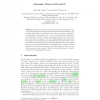Free Online Productivity Tools
i2Speak
i2Symbol
i2OCR
iTex2Img
iWeb2Print
iWeb2Shot
i2Type
iPdf2Split
iPdf2Merge
i2Bopomofo
i2Arabic
i2Style
i2Image
i2PDF
iLatex2Rtf
Sci2ools
85
Voted
WEA
2007
Springer
2007
Springer
Dynamic Trees in Practice
Dynamic tree data structures maintain forests that change over time through edge insertions and deletions. Besides maintaining connectivity information in logarithmic time, they can support aggregation of information over paths, trees, or both. We perform an experimental comparison of several versions of dynamic trees: ST-trees, ET-trees, RC-trees, and two variants of top trees (self-adjusting and worst-case). We quantify their strengths and weaknesses through tests with various workloads, most stemming from practical applications. We observe that a simple, linear-time implementation is remarkably fast for graphs of small diameter, and that worst-case and randomized data structures are best when queries are very frequent. The best overall performance, however, is achieved by self-adjusting ST-trees.
Related Content
| Added | 09 Jun 2010 |
| Updated | 09 Jun 2010 |
| Type | Conference |
| Year | 2007 |
| Where | WEA |
| Authors | Robert Endre Tarjan, Renato Fonseca F. Werneck |
Comments (0)

